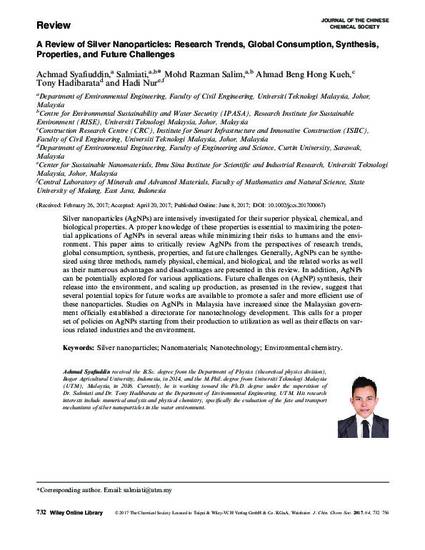
Article
A review of Silver Nanoparticles - Research Trends, Global Consumption, Synthesis, Properties and Future Challenges
Journal of the Chinese Chemical Society
(2017)
Abstract
Silver nanoparticles (AgNPs) are intensively investigated for their superior physical, chemical, and biological properties. A proper knowledge of these properties is essential to maximizing the potential applications of AgNPs in several areas while minimizing their risks to humans and the environment. This paper aims to critically review AgNPs from the perspectives of research trends, global consumption, synthesis, properties, and future challenges. Generally, AgNPs can be synthesized using three methods, namely physical, chemical, and biological, and the related works as well as their numerous advantages and disadvantages are presented in this review. In addition, AgNPs can be potentially explored for various applications. Future challenges on (AgNP) synthesis, their release into the environment, and scaling up production, as presented in the review, suggest that several potential topics for future works are available to promote a safer and more efficient use of these nanoparticles. Studies on AgNPs in Malaysia have increased since the Malaysian government officially established a directorate for nanotechnology development. This calls for a proper set of policies on AgNPs starting from their production to utilization as well as their effects on various related industries and the environment.
Keywords
- Silver nanoparticles,
- Nanomaterials,
- Nanotechnology,
- Environmental chemistry
Disciplines
Publication Date
Summer April 3, 2017
DOI
10.1002/jccs.201700067
Citation Information
Hadi Nur, Achmad Syafiuddin and Salmiati Salmiati. "A review of Silver Nanoparticles - Research Trends, Global Consumption, Synthesis, Properties and Future Challenges" Journal of the Chinese Chemical Society Vol. 64 (2017) p. 732 - 756 Available at: http://works.bepress.com/hadi_nur/88/
